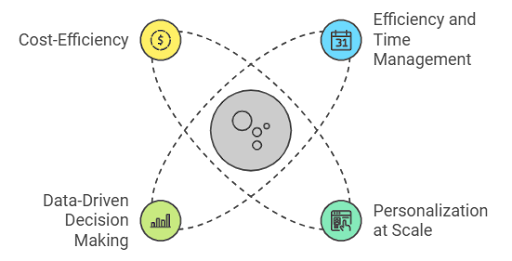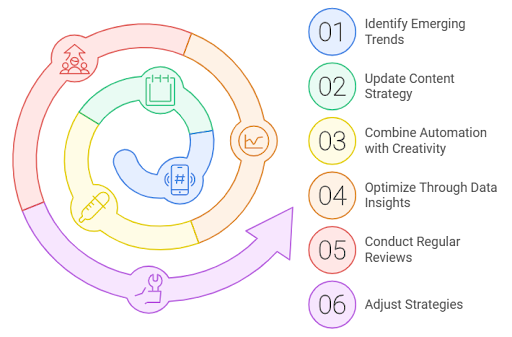In 2023, Singaporean businesses saw a remarkable 38% increase in social media-driven sales after adopting Virtual Content Assistants (VCAs). The ever-evolving landscape of social media demands agility, consistency, and personalization, all of which can be overwhelming to manage manually. VCAs are transforming the way businesses tackle these challenges, automating repetitive tasks while providing real-time, data-driven insights to keep brands relevant and competitive.
Let’s explore how VCAs can optimise your social media strategy, boost engagement, and unlock new opportunities for growth, specifically within Singapore’s unique market landscape.
The Social Media Landscape in Singapore
With a 92% social media penetration rate, Singapore boasts one of the most connected populations in the world. The country’s diverse, multilingual population uses platforms like Instagram, Facebook, TikTok, and LinkedIn to engage with brands. Businesses in Singapore need an omnichannel approach to reach their audiences effectively, but managing multiple platforms can quickly become overwhelming without the right tools.
Here’s a quick snapshot of social media platforms in Singapore:
- Instagram: Popular among millennials and Gen Z, it’s the go-to platform for visually engaging content. Instagram’s audience expects high-quality photos, Reels, and Stories.
- Facebook: With a broader age range, Facebook is essential for businesses looking to build communities and foster direct engagement with users.
- TikTok: Fast-growing and favoured by younger demographics, TikTok’s viral nature can rapidly boost brand visibility.
- LinkedIn: Essential for B2B companies, thought leadership, and professional branding.
Managing these platforms with tailored strategies for each segment can be daunting. This is where VCAs become indispensable.
What is a Virtual Content Assistant?
A Virtual Content Assistant (VCA) automates various aspects of social media management. But VCAs do more than just automate—they provide actionable insights, allowing businesses to improve their engagement strategies over time.
Key Capabilities of a VCA:
- Content Scheduling: VCAs allow businesses to schedule posts in advance across multiple platforms, ensuring consistent and timely content delivery.
- Customer Engagement: They can manage customer responses, monitoring comments and direct messages to provide timely, relevant replies. This is crucial in Singapore, where immediate responses often boost customer satisfaction.
- Data Analytics: VCAs provide detailed analytics, tracking metrics like reach, impressions, click-through rates, and conversions. This helps businesses understand what works, what doesn’t, and how to adjust accordingly.
- Content Curation: VCAs can curate relevant content for sharing based on trending topics, improving engagement without requiring manual input.
How a Virtual Content Assistant Transforms Your Social Media Strategy

Efficiency and Time Management
The average business spends 8-10 hours per week managing social media platforms, creating content, and monitoring engagement. VCAs dramatically reduce this time by automating these tasks, ensuring posts are published at optimal times for engagement without human intervention.
For example, a restaurant in Singapore can schedule posts promoting special menus during peak dining hours, freeing staff to focus on in-person customer service rather than social media management.
Personalization at Scale
In Singapore’s multicultural society, personalised content is key to engaging diverse audiences. VCAs allow businesses to scale personalization by segmenting audiences based on demographics, language preferences, and behaviours. This is particularly useful when crafting content for different language groups (English, Mandarin, Malay, Tamil), ensuring that each audience segment feels valued.
For example, an online retailer could automatically generate personalised offers in different languages for upcoming cultural festivals like Chinese New Year or Hari Raya.
Data-Driven Decision Making
Social media algorithms are constantly changing, making it difficult to predict what will work. A VCA provides real-time insights into content performance, tracking metrics such as engagement, reach, and conversion. This allows businesses to adjust strategies on the fly, ensuring content resonates with the target audience.
Imagine launching a social media campaign in Singapore promoting a new product. After one week, your VCA reports that TikTok is outperforming Instagram in engagement. Based on this insight, you can shift your budget toward producing more short-form video content, which is clearly resonating with your audience.
Cost-Efficiency
Many businesses in Singapore, particularly small and medium enterprises (SMEs), find it cost-prohibitive to hire full-time social media teams. VCAs offer an affordable alternative by automating tasks that would typically require a larger staff. This results in substantial savings while ensuring high-quality social media management.
A VCA can act as a digital assistant, taking over repetitive tasks such as scheduling, content optimization, and engagement tracking, allowing your human team to focus on strategic and creative tasks.
Step-by-Step Guide to Implementing a Virtual Content Assistant
Assess Your Social Media Goals and Pain Points
Before implementing a VCA, it’s essential to evaluate your current social media strategy to identify where automation will add the most value. This assessment should include:
- Content Gaps: Are you able to post consistently, or do you struggle with maintaining a regular schedule?
- Engagement Levels: Are you responding to customer interactions quickly enough? Are there gaps in addressing customer feedback or DMs?
- Analytics and Optimization: Are you using data to guide your decisions? If you aren’t currently tracking key performance indicators (KPIs), a VCA can provide much-needed insight.
- Audience Segmentation: Are you effectively reaching different audience groups (e.g., demographics, regions, or behaviours), or does your messaging feel one-size-fits-all?
By identifying these challenges, you can better align your business goals with the right VCA capabilities.
Choose the Right Virtual Content Assistant for Your Needs
Once you have a clear understanding of your social media goals, the next step is to select the right VCA. Different tools offer unique features, so it’s important to choose one that aligns with your priorities:
- Hootsuite: This tool is excellent for managing content across multiple platforms. It also provides in-depth analytics, making it ideal for businesses that need to track detailed performance metrics.
- Buffer: Best for scheduling posts in advance and simplifying the management of multiple accounts. It’s perfect for teams that prioritise a streamlined, user-friendly dashboard.
- Sprout Social: Known for its powerful engagement tools, Sprout Social offers excellent CRM integration, allowing businesses to track customer conversations across platforms.
- Later: A top choice for businesses that rely heavily on visual content, such as those focused on Instagram and TikTok. Later offers integrated design tools and analytics specifically tailored to visual platforms.
To choose the right VCA, assess each platform’s strengths and how they align with your specific needs. Some businesses may require a VCA focused on analytics, while others may need strong content curation features.
Onboarding and Training Your Team
Proper onboarding and training are crucial to successfully integrating a VCA into your operations. After selecting the right tool, ensure your team understands how to use it effectively:
- Create User Guidelines: Develop clear guidelines for how the VCA will be used. Who will manage content scheduling? Who will monitor analytics and engagement? Defining roles is essential.
- Utilise Onboarding Support: Many VCA platforms provide comprehensive onboarding support, including tutorials, webinars, and live customer service to help your team get started.
- Assign Specific Tasks: Clearly delegate tasks among your team to avoid confusion. For example, one team member could handle analytics reporting, while another focuses on customer engagement.
By establishing a workflow around the VCA, you ensure smoother day-to-day operations and prevent overlap or confusion regarding responsibilities.
Continuous Monitoring and Optimization
A VCA’s true value lies in its ability to optimise over time. To get the most out of your VCA, you should:
- Regularly Review Analytics: Monitor your social media performance data on a weekly or monthly basis. Key metrics such as engagement rate, conversion rate, and reach can help guide decisions about future content.
- A/B Testing: Use your VCA to run A/B tests on different post formats, times, and content styles. Over time, the data will reveal what resonates most with your audience.
- Real-Time Adjustments: Take advantage of the VCA’s ability to make real-time changes. For instance, if a particular post underperforms, you can quickly adjust your strategy by shifting resources to better-performing content types.
Avery Outsourcing: Your Partner in Social Media Excellence
Why Avery Outsourcing Stands Out in Singapore
Singapore’s dynamic market requires businesses to remain agile, efficient, and locally relevant. Avery Outsourcing understands these nuances and offers a suite of services that simplify social media management, allowing businesses to focus on growth while ensuring their online presence thrives.
Core Value Propositions
- Expertise in Local Markets: Singapore has a unique social media ecosystem. Avery Outsourcing’s team provides deep local expertise, ensuring content is culturally relevant and resonates with specific demographic groups, whether targeting English-speaking, Mandarin-speaking, or Malay-speaking audiences.
- AI-Driven Efficiency: By leveraging AI tools, Avery streamlines content creation, scheduling, and analytics tracking. AI can predict peak engagement times, suggest optimised content strategies, and automate interactions like customer queries.
- Scalable Solutions for Any Business Size: Whether you’re a startup looking to establish a social media presence or a large enterprise aiming to optimise operations, Avery Outsourcing offers solutions that grow with your business. From daily posting schedules to advanced analytics, their services are designed to evolve alongside your needs.
Key Services
- Automated Social Media Management: Avery Outsourcing uses AI-driven VCAs to manage daily content posting, engagement monitoring, and trend analysis. This ensures that your social media accounts remain active and relevant without requiring manual oversight.
- Personalised Content Strategies: With a focus on the Singaporean market, Avery ensures that each piece of content is tailored to resonate with local culture, preferences, and behaviours.
- In-Depth Data Analysis: Regular performance reports help you understand which strategies are working and where there’s room for improvement, allowing for continuous optimization.
Why Choose Avery Outsourcing?
- Cutting-edge technology: Benefit from AI-powered tools that optimise your social media efforts.
- Local market expertise: Work with professionals who understand Singapore’s diverse market and its unique social media landscape.
- Scalable and customizable solutions: Services designed to fit businesses of all sizes, ensuring flexibility and cost-efficiency.
Maximising ROI with a Virtual Content Assistant
Time Efficiency Leads to Cost Savings
VCAs save your business both time and money by automating tasks that would typically require human labour. On average, businesses spend around 15 hours per week managing social media accounts manually. By implementing a VCA, you free up these hours, allowing your team to focus on strategic initiatives and creative work.
Additionally, by scheduling posts in advance, a VCA eliminates the need for constant manual monitoring. This translates into cost savings, especially for SMEs that may not have the budget for a large social media team.
Better Audience Targeting = Higher Conversions
VCAs use data to optimise audience segmentation, ensuring that each post reaches the right group at the right time. By analysing user behaviour, VCAs can refine targeting efforts, which leads to higher engagement and conversions.
For example, if your business sells skincare products, a VCA might identify that your Instagram audience engages most with posts about seasonal skincare routines. By increasing the frequency of similar posts during relevant seasons, your VCA can boost both engagement and sales.
Enhanced Engagement Through Automation
VCAs help businesses respond to customer interactions quickly and efficiently. Automated engagement tools ensure that no comment, message, or inquiry goes unanswered. This helps increase customer satisfaction and fosters loyalty, as consumers appreciate timely responses.
In Singapore, where consumer expectations for rapid responses are high, this automation ensures that your brand is always engaging with its audience without overwhelming your team with manual tasks.
Real-Time Adjustments for Better ROI
One of the major advantages of using a VCA is the ability to adjust campaigns in real-time. If a post isn’t performing well, your VCA can suggest changes such as adjusting the content format or rescheduling the post for a time when your audience is more active. These quick adjustments can prevent campaigns from underperforming and ensure you get the most out of your marketing budget.
Best Practices for Sustaining Social Media Success with a VCA

Stay Agile with Emerging Trends
Social media trends are constantly evolving, and VCAs give businesses the flexibility to adapt quickly. Use your VCA’s data insights to identify emerging trends or shifts in user behaviour. Whether it’s a new content format (like Instagram Reels or TikTok videos) or a trending hashtag, staying agile ensures your brand remains relevant.
Regularly update your content strategy to include new platforms or features, and don’t be afraid to experiment. VCAs can help run A/B tests to determine the best content formats and posting times, so you can adapt to changes without risking engagement.
Combine Automation with Creativity
While VCAs excel at automating routine tasks, don’t forget the importance of human creativity in social media success. Use the time saved by automation to focus on creative, high-quality content that resonates emotionally with your audience. Engaging visuals, compelling stories, and authentic brand voice are elements that only humans can fully bring to life, even in an automated workflow.
Regular Optimization Through Data Insights
A key part of sustaining long-term success with a VCA is continuous optimization. Social media strategies should evolve based on real-time data, and VCAs provide the perfect tools for ongoing analysis. Set up monthly or quarterly reviews where your team examines performance metrics such as engagement rates, follower growth, and conversion data.
The insights gained during these reviews should guide your content decisions, ensuring that your brand remains agile and capable of adjusting to market changes. Regularly tweak your strategies to reflect what’s working, while phasing out content or tactics that no longer deliver strong results.
Integrating a Virtual Content Assistant with Other Marketing Tools
A Virtual Content Assistant (VCA) can serve as the foundation of your social media strategy, but to truly optimise your marketing efforts, it’s crucial to integrate the VCA with other key digital marketing tools. Seamless integration enhances efficiency, data gathering, and consistency across marketing channels. Here are some key tools to consider integrating with your VCA:
CRM Systems for Enhanced Personalization
- Why It Matters: Integrating a VCA with your Customer Relationship Management (CRM) system enables you to pull in customer data, allowing for hyper-targeted social media campaigns. You can sync your audience segmentation data directly into your VCA, ensuring that each post, message, or promotion speaks to the specific interests and behaviours of your customers.
- Practical Example: A VCA integrated with HubSpot or Salesforce allows a business to automate follow-up messages or social media engagements that align with the customer journey (e.g., sending offers to returning customers).
Email Marketing Platforms for Cross-Channel Consistency
- Why It Matters: While VCAs streamline social media management, integrating with an email marketing platform like Mailchimp or ActiveCampaign ensures a consistent message across multiple channels. This integration allows businesses to create unified campaigns, where email and social posts reinforce each other.
- Practical Example: A product launch announcement can be simultaneously promoted via email and through a well-timed social media post, ensuring maximum exposure.
Analytics Platforms for Deeper Insights
- Why It Matters: While most VCAs provide their own analytics, integrating with specialised platforms like Google Analytics or SEMrush delivers more granular insights. These tools help track user behaviour beyond social media, providing a full picture of your campaign’s effectiveness.
- Practical Example: Use your VCA’s performance insights to track which social media posts drive the most website traffic, and leverage Google Analytics to identify how that traffic behaves on your website (e.g., bounce rates, conversions).
Ad Platforms for Paid Social Media Campaigns
- Why It Matters: Integration with advertising platforms such as Facebook Ads Manager or Google Ads enables businesses to optimise both organic and paid campaigns. VCAs can be used to A/B test organic content, and the findings can inform paid strategies.
- Practical Example: If a certain type of post drives more engagement organically, your VCA can suggest using similar content for paid ads to maximise ROI.
Industry-Specific Applications of Virtual Content Assistants
Virtual Content Assistants aren’t just for general use—they can be tailored for different industries to meet specific needs. Let’s explore how VCAs can benefit key sectors by automating workflows and improving customer interactions.
E-commerce and Retail
In the e-commerce sector, social media is a key driver for traffic and sales. A VCA enables online retailers to automate personalised recommendations, manage customer inquiries, and track product-specific trends.
- Automation of Sales Announcements: VCAs can schedule posts for new product launches or flash sales, ensuring that promotions are seen by customers at optimal times.
- Customer Interaction: By automating responses to frequently asked questions, such as product availability or shipping updates, VCAs free up time for your customer service team.
Hospitality and Tourism
For businesses in the hospitality sector, social media is crucial for brand awareness, engagement, and customer trust. VCAs help schedule seasonal promotions, manage reviews, and engage with guests in real time.
- Personalised Guest Interaction: VCAs can send personalised messages based on customer preferences, promoting packages tailored to specific demographics (e.g., family packages or romantic getaways).
- Managing Reviews and Reputation: Automate responses to reviews on platforms like TripAdvisor or Google Reviews to maintain a positive brand image while quickly addressing negative feedback.
Education and Nonprofits
In the education and nonprofit sectors, VCAs can streamline outreach efforts, build community engagement, and promote events.
- Community Engagement: VCAs help institutions maintain consistent communication with their communities, whether through posting updates, event information, or stories of impact.
- Volunteer or Student Recruitment: Automate content that highlights success stories or upcoming recruitment events, ensuring you reach the right audience on platforms like LinkedIn or Instagram.
Leveraging VCAs for Crisis Management and Real-Time Updates
Social media plays a vital role in crisis management and delivering timely updates to the public. In moments of urgency, VCAs can help businesses maintain control of their messaging, ensuring a quick response while minimising human error.
Immediate Response Protocols
VCAs allow businesses to pre-program responses or alert messages in the event of an emergency. Whether you’re responding to a PR crisis, addressing a service outage, or communicating updates related to natural disasters, VCAs can help maintain clear, consistent messaging across platforms.
Example: A telecommunications company can use a VCA to instantly inform customers of service disruptions while updating them on restoration progress via Twitter or Facebook.
Real-Time Monitoring for Reputation Management
A VCA can monitor your brand’s mentions across platforms, alerting your team if certain negative keywords appear frequently. This allows businesses to respond immediately, preventing damage to the brand’s reputation.
Example: A food delivery service can set up automated alerts for mentions of long delivery times, ensuring prompt action before these complaints escalate on social media.
Expanding Beyond Social Media: The Future of Virtual Content Assistants
As VCAs evolve, their functionality is expanding beyond social media to encompass broader digital marketing responsibilities. The future of VCAs lies in their ability to act as centralised marketing hubs, capable of managing entire digital ecosystems.
Integrated Content Marketing
In the future, VCAs will integrate even further with content management systems (CMS), enabling businesses to manage blog posts, videos, email newsletters, and website content from one platform.
Example: Imagine scheduling blog posts and automating social media teasers that promote each blog post simultaneously, all managed by a single assistant.
AI-Driven Customer Journey Management
VCAs will increasingly leverage AI to analyse customer journeys, optimising touch points across all digital platforms. From a customer’s first social media interaction to the final purchase, VCAs will play a role in nurturing leads at every stage of the funnel.
Example: A travel agency could use a VCA to monitor when customers engage with travel-related content and follow up with personalised offers tailored to their recent searches or interests.
Cross-Platform Integration for a Seamless Brand Experience
VCAs will soon be capable of managing seamless customer experiences across platforms—from email to social media to chatbot interactions. This integration allows for more cohesive and consistent brand messaging across channels.
Example: A fitness brand could use a VCA to deliver a cohesive experience where customers receive email tips, follow up with social media posts, and receive chatbot-guided workout suggestions, all tailored to their fitness goals.
Transform Your Social Media Strategy Today
Elevate your social media performance with Avery Outsourcing. Contact us today to discover how our AI-driven Virtual Content Assistants can help your business automate tasks, optimise engagement, and achieve greater ROI. Book a free consultation now and start maximising your brand’s potential across all major platforms.




